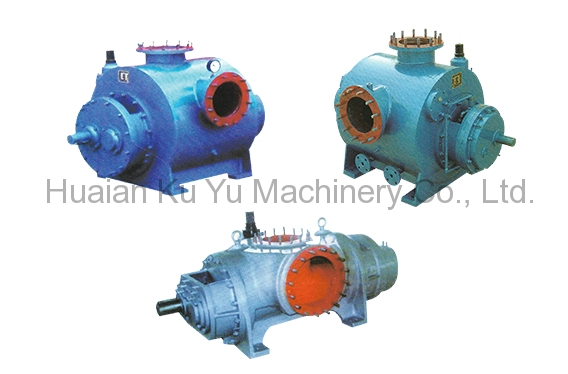Huaian Ku Yu Machinery Co., Ltd.
Telephone:0517-83717380
Phone:18952335311
Zip code:23005
Fax:0517-83712629
mailbox:kysunfang @163.com
URL:www.hakyjx.com

The screw pump is a kind of metering pump. Today, we have to talk about the relationship between the flow and pressure of the screw pump.
It is well known that the pump of the screw pump exceeds 2000gal/rnin. Large screw pump (under the differential pressure of 70 psi with a 200 HP motor and gear reducer, the pump can run under 150 r/min speed) under normal circumstances, the pressure under the high flow velocity is low, for reasons of manufacturing, is often a few pump installed in parallel, in order to decrease the size of a single pump. Even if the rubber and rotor work closely together, the higher the pressure means the easier it is to slip and the slip will significantly reduce the net flow. That's why the higher the pressure difference, the more class you need.
As a rule of thumb, the screw pump design has a normal pressure difference of 75psi. For example, a pressure differential of 300psi requires four or five levels of the pump (as high as possible). In order to have a preliminary understanding of all the parameters of the screw pump, discuss the following examples. In the example, a screw pump was needed to overcome 300gal/min of liquid at 300psi differential pressure.
When selecting a pump for a large hour, the design engineer USES formulas and charts and references to theoretical and empirical data: for example, the rate of wear and the maximum velocity of the particle is the basic limiting factor for pump speed. However, the user of the pump has no way to master this particular message: even a relatively simple standard value, such as the determination of average velocity, needs to know the net flow area. And the net flow area is only the user already has a running pump to measure. Obviously, most users don't have a pump when evaluating and selecting pumps.
If a comparison characteristic curve can be found in the list, it is a convenient way to estimate the size of the pump required by the pump. However, because a list is not always available, it is best to have some simple, easy ways to estimate all the parameters of the pump. The practice proves that this approximation method is feasible if the nominal size of the connection line is known. This method is usually available regardless of type of pump. Even if the diameter of the tube changes with the viscosity of the fluid (the more viscous fluid requires the larger pipe diameter), the change is relatively stable and knowable, especially for the approximate standard.
The rule of thumb for approximating the size of the pump is that the nominal size of the tube is between 1 and 3f/s. The small pump usually USES a smaller velocity (LFT/s), with larger pump velocity (3ft/s) :
U pipe =Q * 0.321/A flange.
=Q * 0.321 / (3. 14 x d flange 2/4)
In the above example (300gal/min, 300 psi), let's assume that the flow rate is 2ft/s for an average size pump. If the above equation is derived for the flange diameter (i.e., pump diameter), we get:
D flange =[4 * Q * 0.321/(3. 14 x u)]0.5
= [4 * 300 * 0.321/14 (2) (3)] = 7 8 in 0.5
Therefore, a pipeline with a nominal diameter of 8in (pump flanges) can be used.
The total length of the hydraulic part (rotor of the stator) can be changed, but as the first estimate, the length of the 1 pump is approximately equal to 4 nominal diameters.
The L1 is approximately 4 x d flanges. =4 x 8=32in
Use a 5 stage pump (at 300psi differential pressure, per level of 75psi, plus a safety factor) :
L hydraulic =5 x 32= 160in drive end plus an extra length, at least not less than 1 or 2-stage pump length. Get:
L pump = 160 +32 x2= 220 ~ 230in approximately 20ft!
In order to reduce the floor area, the screw pump is often driven by a belt driven by a back-up motor.
The same theory applies to small pumps, such as 20 gal/min and the same 300psi differential pressure:
D flange =(4 x 20 x 0.321)/(3. 14 x l)0.5
=2 9in, about 3in (applying LFT/s)
So it's going to be 4 X 3= 12in
L hydraulic =5 x 12= 60in;
L pump = 60 + 12 x2 = 84 in or about 7 ft should admit that the above assumption is very close, but this example also illustrates the point, compared to most other types of pumps, a standard of screw pump, the same motor connection and fixed on the floor, may need to double the size of the area. In addition, if the amount of abrasive material is high, the 75psi pressure drop rating should be reduced or even reduced, thus making the whole pump longer.
This explains why the screw pump is usually difficult to replace other types of pumps, even problems, installed pumps (the pump is usually crowded with other equipment). However, for outdoor installations, especially for new installations, this is not a problem, as the area plan is being developed, and for larger pumps, the area is easy to adjust.
Huaian Ku Yu Machinery Co., Ltd.

Address: Fuzhou Road 12, Huaian economic and Technological Development Zone
URL:www.hakyjx.com

